Marketing Management Report: Tesco's International Market Analysis
VerifiedAdded on 2022/11/26
|12
|2826
|255
Report
AI Summary
This report provides a critical analysis of Tesco's international marketing opportunities, with a specific focus on the Australian market. It examines Tesco's market entry strategies, including acquisitions and joint ventures, and evaluates the competitive landscape. The report further explores the development of creative marketing strategies for international expansion, such as building a local presence, creating a global knowledge network, partnering with local businesses, implementing global campaigns, and leveraging social media. The analysis considers consumer trends, economic factors, and the competitive environment to propose effective marketing approaches for Tesco's growth in international markets. This report is a valuable resource for understanding Tesco's global marketing strategies and the challenges and opportunities it faces in expanding its international presence, particularly in Australia.
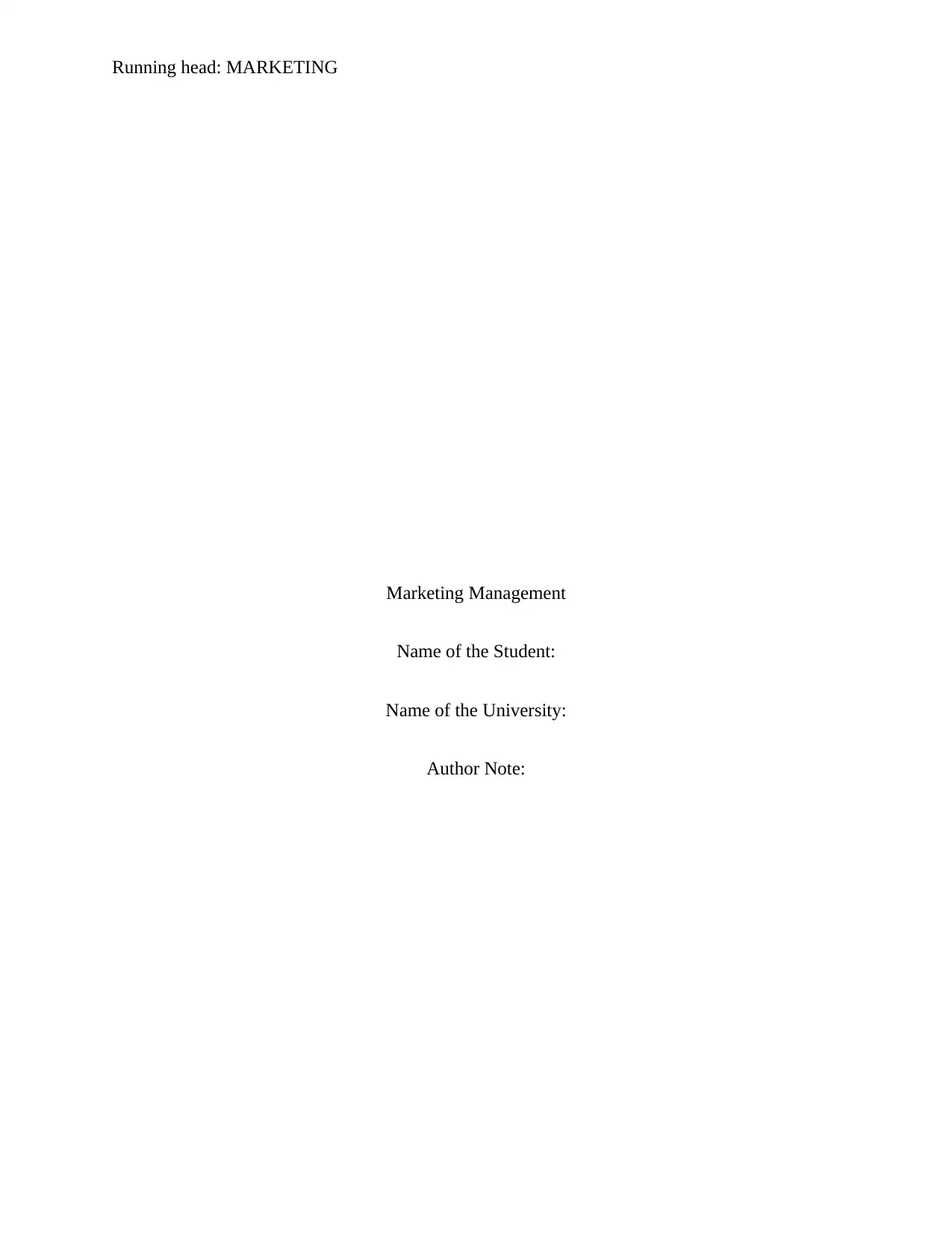
Running head: MARKETING
Marketing Management
Name of the Student:
Name of the University:
Author Note:
Marketing Management
Name of the Student:
Name of the University:
Author Note:
Paraphrase This Document
Need a fresh take? Get an instant paraphrase of this document with our AI Paraphraser
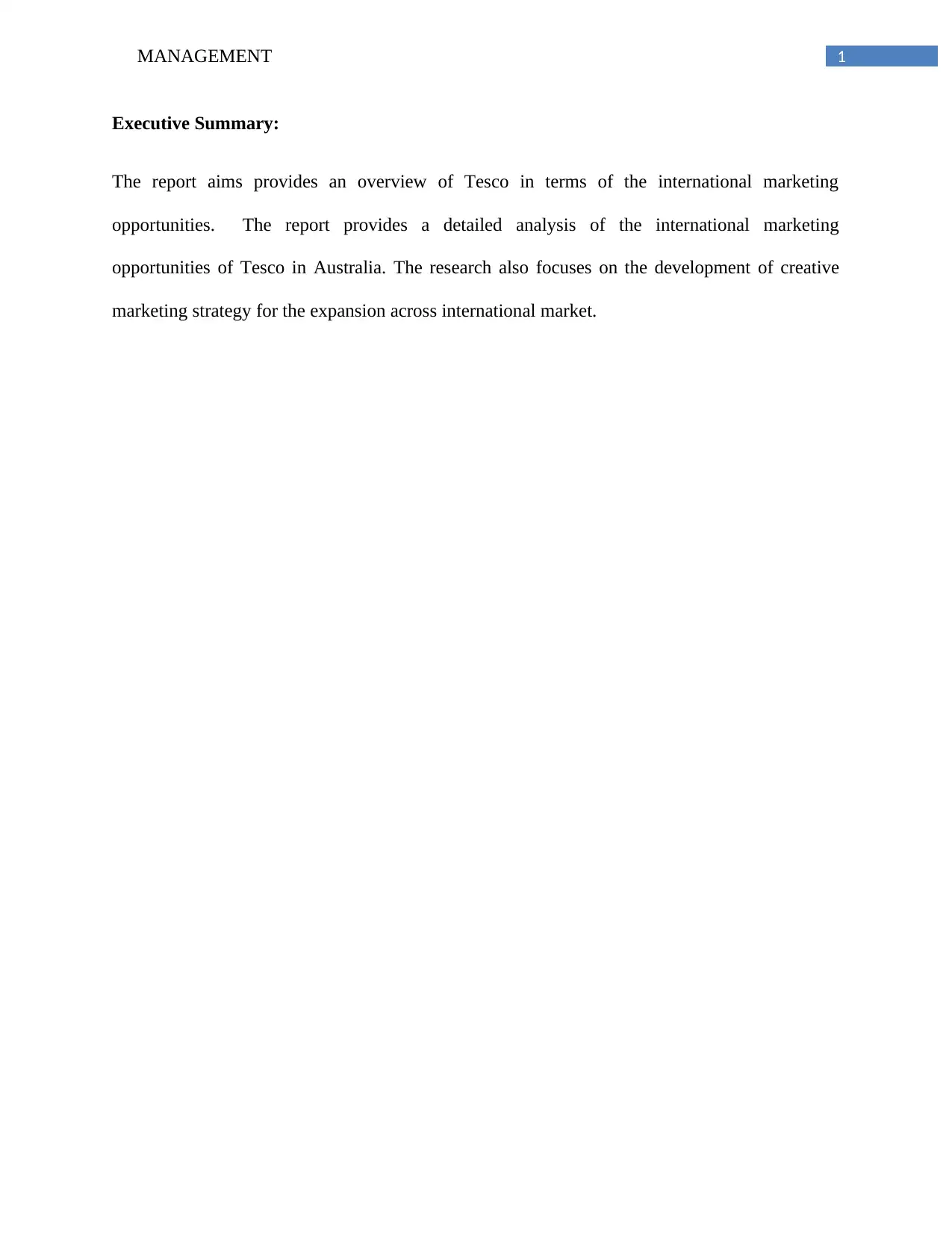
1MANAGEMENT
Executive Summary:
The report aims provides an overview of Tesco in terms of the international marketing
opportunities. The report provides a detailed analysis of the international marketing
opportunities of Tesco in Australia. The research also focuses on the development of creative
marketing strategy for the expansion across international market.
Executive Summary:
The report aims provides an overview of Tesco in terms of the international marketing
opportunities. The report provides a detailed analysis of the international marketing
opportunities of Tesco in Australia. The research also focuses on the development of creative
marketing strategy for the expansion across international market.
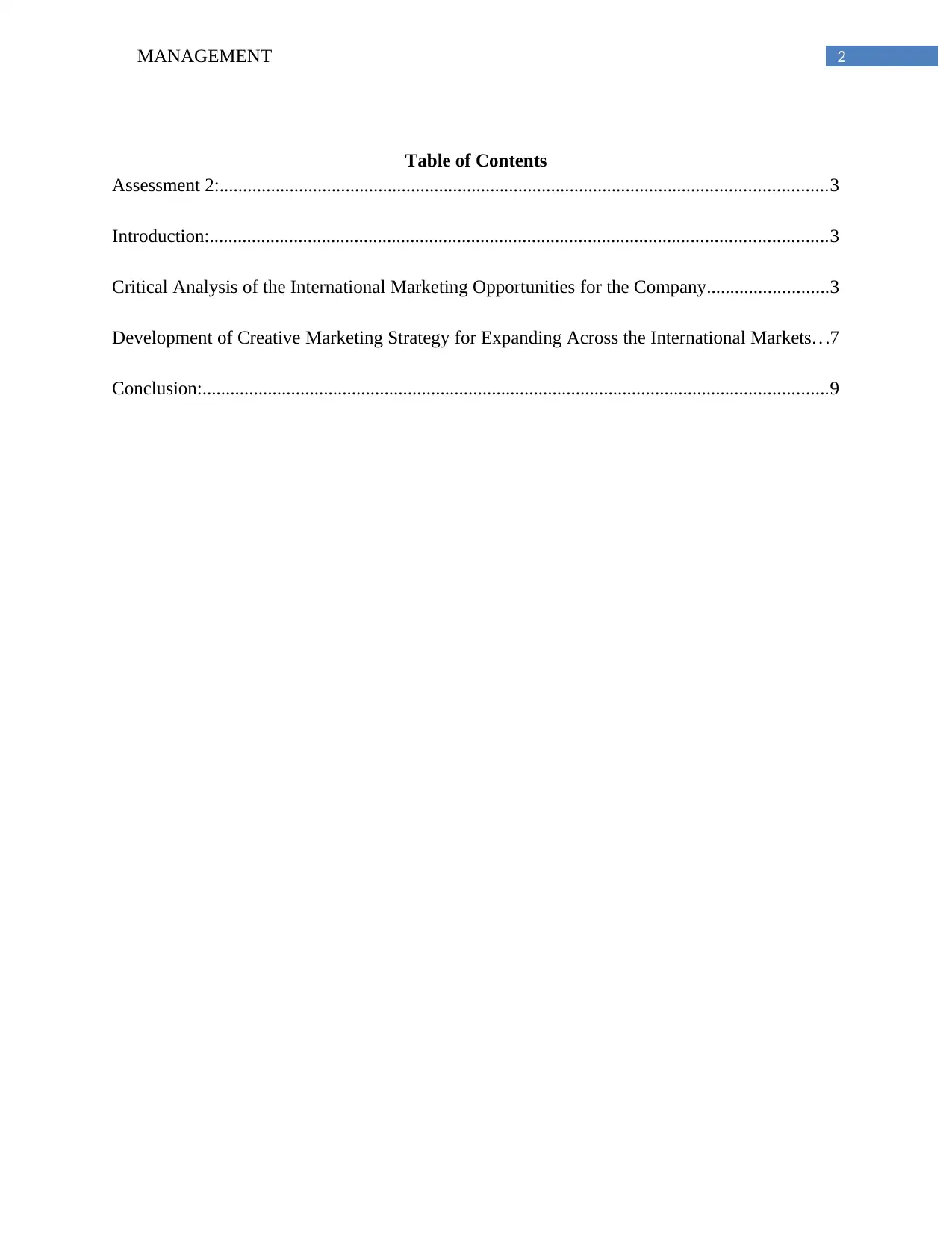
2MANAGEMENT
Table of Contents
Assessment 2:..................................................................................................................................3
Introduction:....................................................................................................................................3
Critical Analysis of the International Marketing Opportunities for the Company..........................3
Development of Creative Marketing Strategy for Expanding Across the International Markets. . .7
Conclusion:......................................................................................................................................9
Table of Contents
Assessment 2:..................................................................................................................................3
Introduction:....................................................................................................................................3
Critical Analysis of the International Marketing Opportunities for the Company..........................3
Development of Creative Marketing Strategy for Expanding Across the International Markets. . .7
Conclusion:......................................................................................................................................9
⊘ This is a preview!⊘
Do you want full access?
Subscribe today to unlock all pages.

Trusted by 1+ million students worldwide
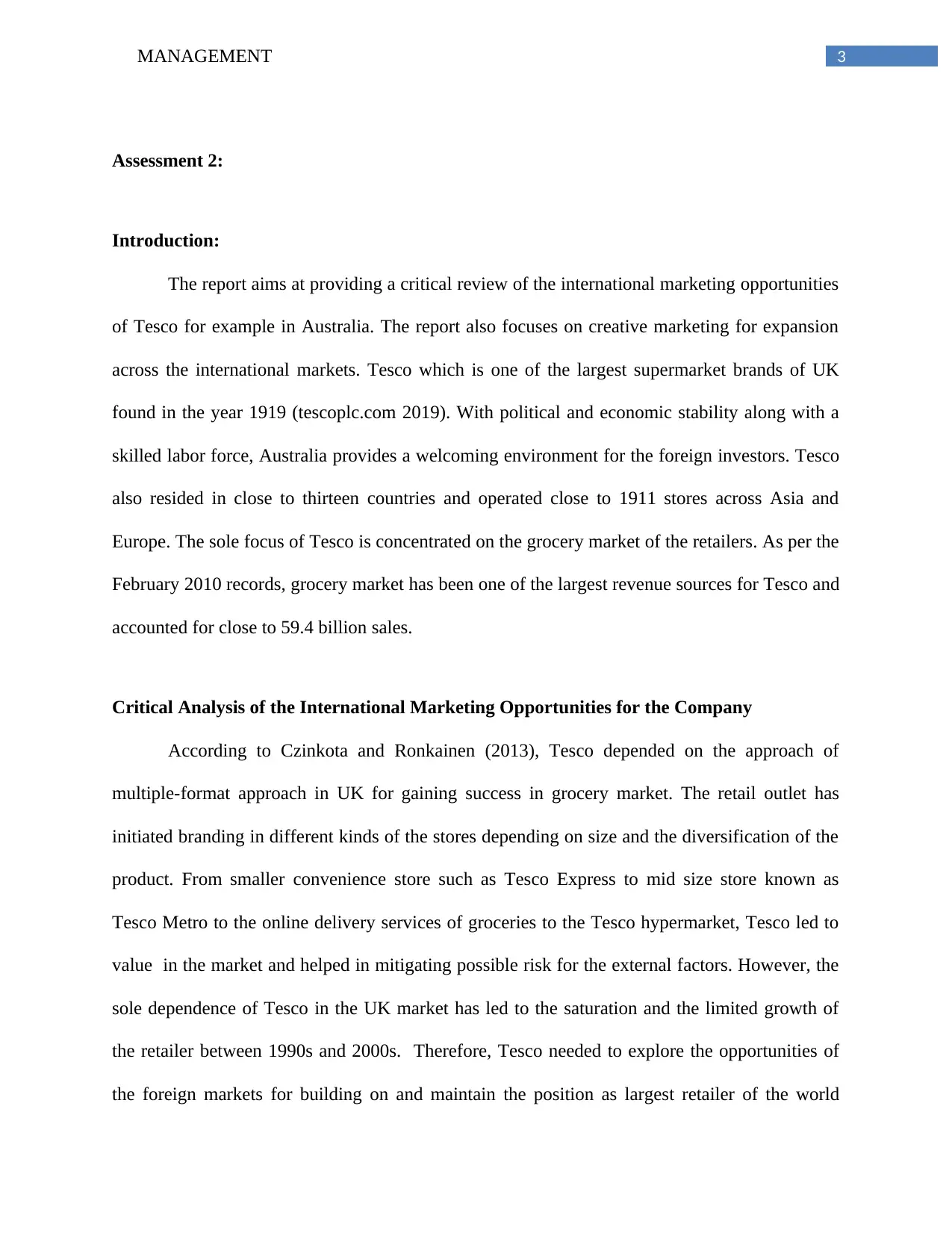
3MANAGEMENT
Assessment 2:
Introduction:
The report aims at providing a critical review of the international marketing opportunities
of Tesco for example in Australia. The report also focuses on creative marketing for expansion
across the international markets. Tesco which is one of the largest supermarket brands of UK
found in the year 1919 (tescoplc.com 2019). With political and economic stability along with a
skilled labor force, Australia provides a welcoming environment for the foreign investors. Tesco
also resided in close to thirteen countries and operated close to 1911 stores across Asia and
Europe. The sole focus of Tesco is concentrated on the grocery market of the retailers. As per the
February 2010 records, grocery market has been one of the largest revenue sources for Tesco and
accounted for close to 59.4 billion sales.
Critical Analysis of the International Marketing Opportunities for the Company
According to Czinkota and Ronkainen (2013), Tesco depended on the approach of
multiple-format approach in UK for gaining success in grocery market. The retail outlet has
initiated branding in different kinds of the stores depending on size and the diversification of the
product. From smaller convenience store such as Tesco Express to mid size store known as
Tesco Metro to the online delivery services of groceries to the Tesco hypermarket, Tesco led to
value in the market and helped in mitigating possible risk for the external factors. However, the
sole dependence of Tesco in the UK market has led to the saturation and the limited growth of
the retailer between 1990s and 2000s. Therefore, Tesco needed to explore the opportunities of
the foreign markets for building on and maintain the position as largest retailer of the world
Assessment 2:
Introduction:
The report aims at providing a critical review of the international marketing opportunities
of Tesco for example in Australia. The report also focuses on creative marketing for expansion
across the international markets. Tesco which is one of the largest supermarket brands of UK
found in the year 1919 (tescoplc.com 2019). With political and economic stability along with a
skilled labor force, Australia provides a welcoming environment for the foreign investors. Tesco
also resided in close to thirteen countries and operated close to 1911 stores across Asia and
Europe. The sole focus of Tesco is concentrated on the grocery market of the retailers. As per the
February 2010 records, grocery market has been one of the largest revenue sources for Tesco and
accounted for close to 59.4 billion sales.
Critical Analysis of the International Marketing Opportunities for the Company
According to Czinkota and Ronkainen (2013), Tesco depended on the approach of
multiple-format approach in UK for gaining success in grocery market. The retail outlet has
initiated branding in different kinds of the stores depending on size and the diversification of the
product. From smaller convenience store such as Tesco Express to mid size store known as
Tesco Metro to the online delivery services of groceries to the Tesco hypermarket, Tesco led to
value in the market and helped in mitigating possible risk for the external factors. However, the
sole dependence of Tesco in the UK market has led to the saturation and the limited growth of
the retailer between 1990s and 2000s. Therefore, Tesco needed to explore the opportunities of
the foreign markets for building on and maintain the position as largest retailer of the world
Paraphrase This Document
Need a fresh take? Get an instant paraphrase of this document with our AI Paraphraser
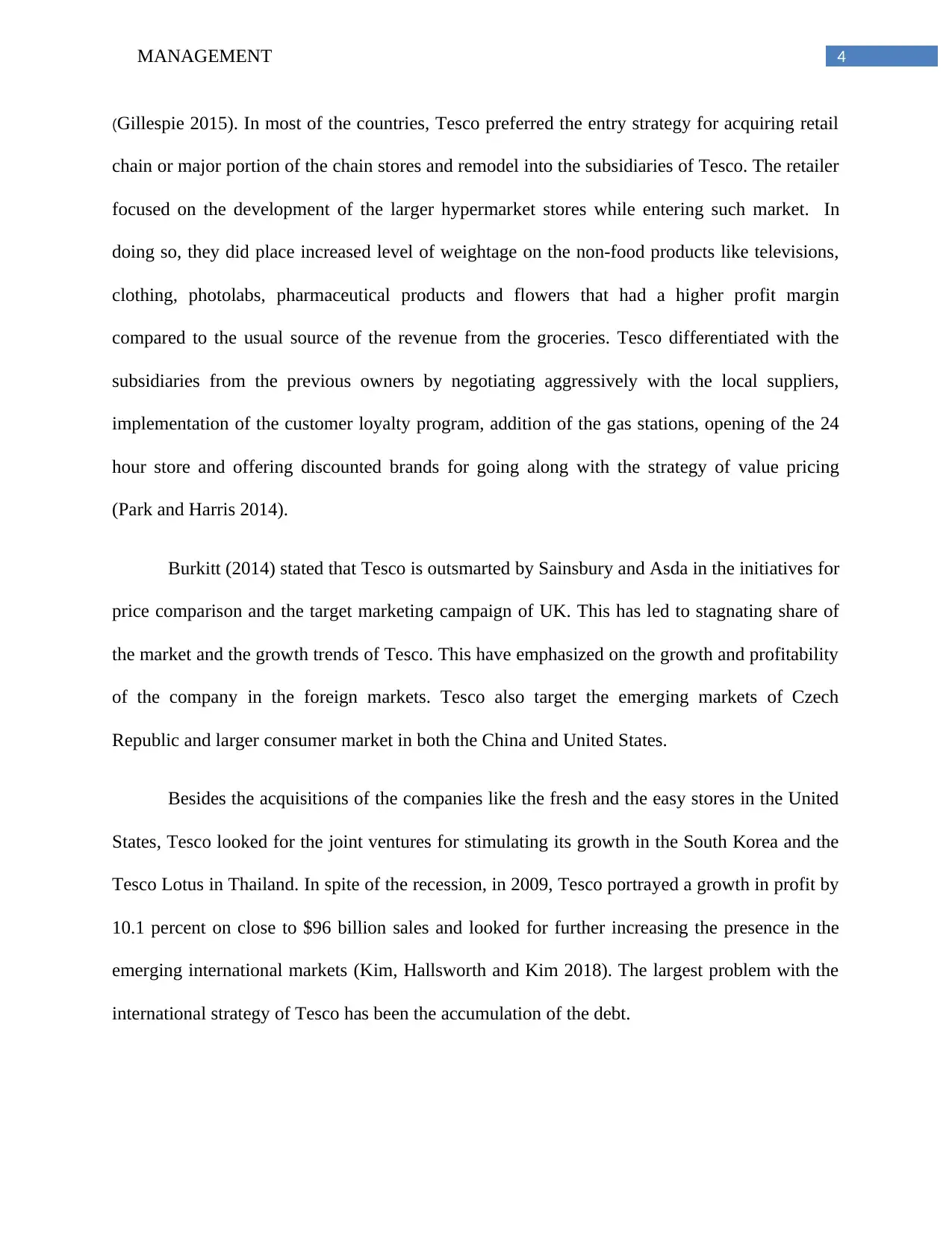
4MANAGEMENT
(Gillespie 2015). In most of the countries, Tesco preferred the entry strategy for acquiring retail
chain or major portion of the chain stores and remodel into the subsidiaries of Tesco. The retailer
focused on the development of the larger hypermarket stores while entering such market. In
doing so, they did place increased level of weightage on the non-food products like televisions,
clothing, photolabs, pharmaceutical products and flowers that had a higher profit margin
compared to the usual source of the revenue from the groceries. Tesco differentiated with the
subsidiaries from the previous owners by negotiating aggressively with the local suppliers,
implementation of the customer loyalty program, addition of the gas stations, opening of the 24
hour store and offering discounted brands for going along with the strategy of value pricing
(Park and Harris 2014).
Burkitt (2014) stated that Tesco is outsmarted by Sainsbury and Asda in the initiatives for
price comparison and the target marketing campaign of UK. This has led to stagnating share of
the market and the growth trends of Tesco. This have emphasized on the growth and profitability
of the company in the foreign markets. Tesco also target the emerging markets of Czech
Republic and larger consumer market in both the China and United States.
Besides the acquisitions of the companies like the fresh and the easy stores in the United
States, Tesco looked for the joint ventures for stimulating its growth in the South Korea and the
Tesco Lotus in Thailand. In spite of the recession, in 2009, Tesco portrayed a growth in profit by
10.1 percent on close to $96 billion sales and looked for further increasing the presence in the
emerging international markets (Kim, Hallsworth and Kim 2018). The largest problem with the
international strategy of Tesco has been the accumulation of the debt.
(Gillespie 2015). In most of the countries, Tesco preferred the entry strategy for acquiring retail
chain or major portion of the chain stores and remodel into the subsidiaries of Tesco. The retailer
focused on the development of the larger hypermarket stores while entering such market. In
doing so, they did place increased level of weightage on the non-food products like televisions,
clothing, photolabs, pharmaceutical products and flowers that had a higher profit margin
compared to the usual source of the revenue from the groceries. Tesco differentiated with the
subsidiaries from the previous owners by negotiating aggressively with the local suppliers,
implementation of the customer loyalty program, addition of the gas stations, opening of the 24
hour store and offering discounted brands for going along with the strategy of value pricing
(Park and Harris 2014).
Burkitt (2014) stated that Tesco is outsmarted by Sainsbury and Asda in the initiatives for
price comparison and the target marketing campaign of UK. This has led to stagnating share of
the market and the growth trends of Tesco. This have emphasized on the growth and profitability
of the company in the foreign markets. Tesco also target the emerging markets of Czech
Republic and larger consumer market in both the China and United States.
Besides the acquisitions of the companies like the fresh and the easy stores in the United
States, Tesco looked for the joint ventures for stimulating its growth in the South Korea and the
Tesco Lotus in Thailand. In spite of the recession, in 2009, Tesco portrayed a growth in profit by
10.1 percent on close to $96 billion sales and looked for further increasing the presence in the
emerging international markets (Kim, Hallsworth and Kim 2018). The largest problem with the
international strategy of Tesco has been the accumulation of the debt.
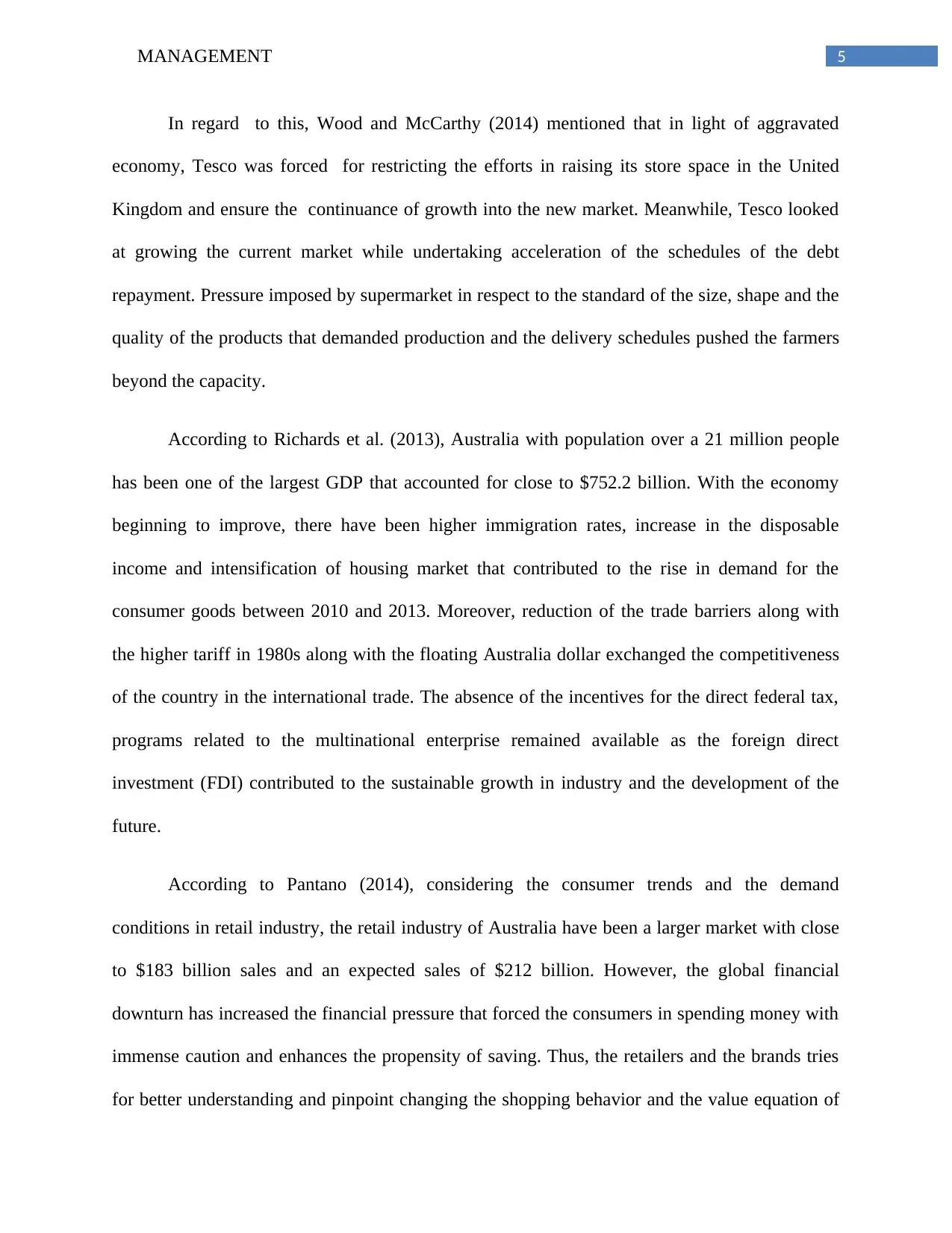
5MANAGEMENT
In regard to this, Wood and McCarthy (2014) mentioned that in light of aggravated
economy, Tesco was forced for restricting the efforts in raising its store space in the United
Kingdom and ensure the continuance of growth into the new market. Meanwhile, Tesco looked
at growing the current market while undertaking acceleration of the schedules of the debt
repayment. Pressure imposed by supermarket in respect to the standard of the size, shape and the
quality of the products that demanded production and the delivery schedules pushed the farmers
beyond the capacity.
According to Richards et al. (2013), Australia with population over a 21 million people
has been one of the largest GDP that accounted for close to $752.2 billion. With the economy
beginning to improve, there have been higher immigration rates, increase in the disposable
income and intensification of housing market that contributed to the rise in demand for the
consumer goods between 2010 and 2013. Moreover, reduction of the trade barriers along with
the higher tariff in 1980s along with the floating Australia dollar exchanged the competitiveness
of the country in the international trade. The absence of the incentives for the direct federal tax,
programs related to the multinational enterprise remained available as the foreign direct
investment (FDI) contributed to the sustainable growth in industry and the development of the
future.
According to Pantano (2014), considering the consumer trends and the demand
conditions in retail industry, the retail industry of Australia have been a larger market with close
to $183 billion sales and an expected sales of $212 billion. However, the global financial
downturn has increased the financial pressure that forced the consumers in spending money with
immense caution and enhances the propensity of saving. Thus, the retailers and the brands tries
for better understanding and pinpoint changing the shopping behavior and the value equation of
In regard to this, Wood and McCarthy (2014) mentioned that in light of aggravated
economy, Tesco was forced for restricting the efforts in raising its store space in the United
Kingdom and ensure the continuance of growth into the new market. Meanwhile, Tesco looked
at growing the current market while undertaking acceleration of the schedules of the debt
repayment. Pressure imposed by supermarket in respect to the standard of the size, shape and the
quality of the products that demanded production and the delivery schedules pushed the farmers
beyond the capacity.
According to Richards et al. (2013), Australia with population over a 21 million people
has been one of the largest GDP that accounted for close to $752.2 billion. With the economy
beginning to improve, there have been higher immigration rates, increase in the disposable
income and intensification of housing market that contributed to the rise in demand for the
consumer goods between 2010 and 2013. Moreover, reduction of the trade barriers along with
the higher tariff in 1980s along with the floating Australia dollar exchanged the competitiveness
of the country in the international trade. The absence of the incentives for the direct federal tax,
programs related to the multinational enterprise remained available as the foreign direct
investment (FDI) contributed to the sustainable growth in industry and the development of the
future.
According to Pantano (2014), considering the consumer trends and the demand
conditions in retail industry, the retail industry of Australia have been a larger market with close
to $183 billion sales and an expected sales of $212 billion. However, the global financial
downturn has increased the financial pressure that forced the consumers in spending money with
immense caution and enhances the propensity of saving. Thus, the retailers and the brands tries
for better understanding and pinpoint changing the shopping behavior and the value equation of
⊘ This is a preview!⊘
Do you want full access?
Subscribe today to unlock all pages.

Trusted by 1+ million students worldwide
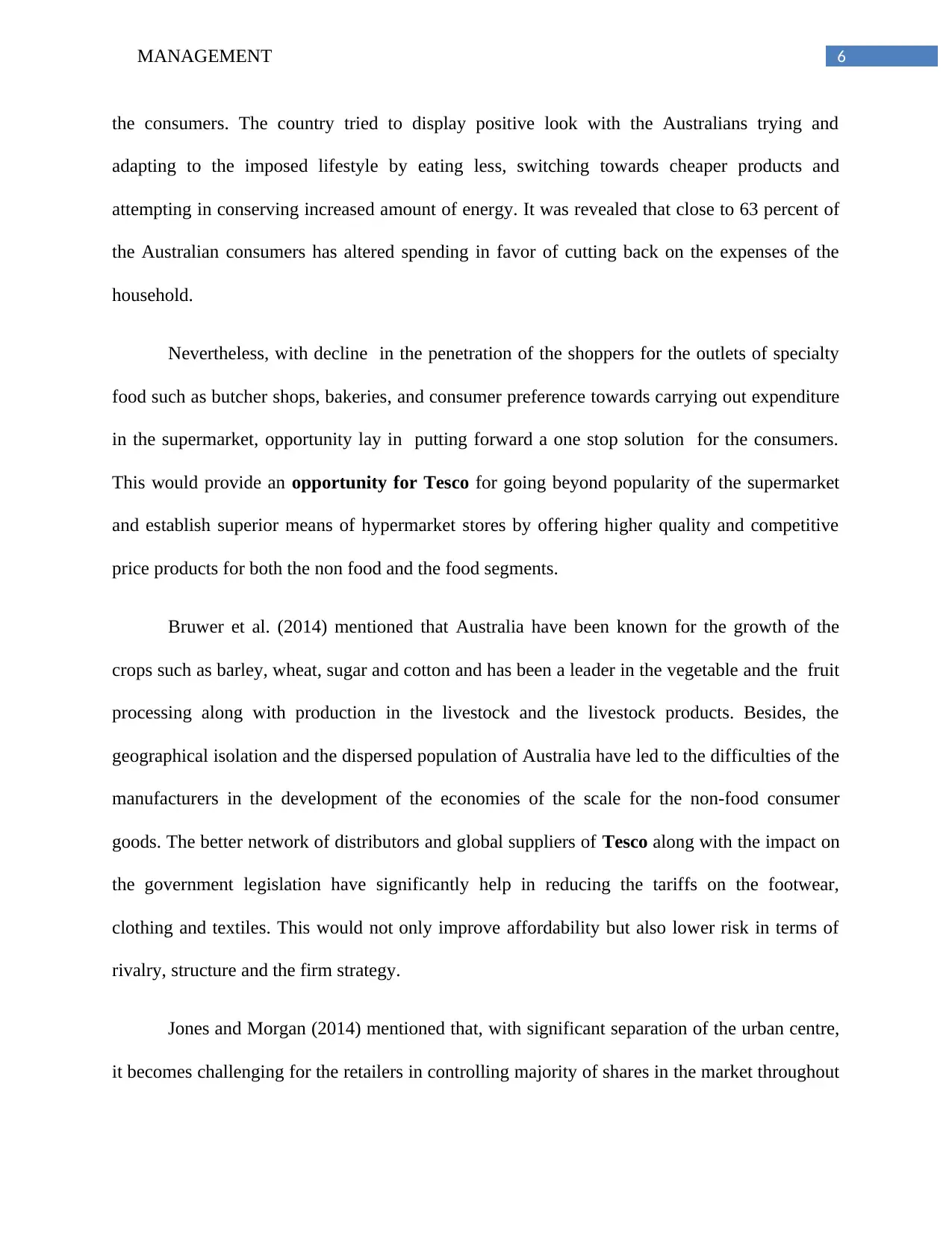
6MANAGEMENT
the consumers. The country tried to display positive look with the Australians trying and
adapting to the imposed lifestyle by eating less, switching towards cheaper products and
attempting in conserving increased amount of energy. It was revealed that close to 63 percent of
the Australian consumers has altered spending in favor of cutting back on the expenses of the
household.
Nevertheless, with decline in the penetration of the shoppers for the outlets of specialty
food such as butcher shops, bakeries, and consumer preference towards carrying out expenditure
in the supermarket, opportunity lay in putting forward a one stop solution for the consumers.
This would provide an opportunity for Tesco for going beyond popularity of the supermarket
and establish superior means of hypermarket stores by offering higher quality and competitive
price products for both the non food and the food segments.
Bruwer et al. (2014) mentioned that Australia have been known for the growth of the
crops such as barley, wheat, sugar and cotton and has been a leader in the vegetable and the fruit
processing along with production in the livestock and the livestock products. Besides, the
geographical isolation and the dispersed population of Australia have led to the difficulties of the
manufacturers in the development of the economies of the scale for the non-food consumer
goods. The better network of distributors and global suppliers of Tesco along with the impact on
the government legislation have significantly help in reducing the tariffs on the footwear,
clothing and textiles. This would not only improve affordability but also lower risk in terms of
rivalry, structure and the firm strategy.
Jones and Morgan (2014) mentioned that, with significant separation of the urban centre,
it becomes challenging for the retailers in controlling majority of shares in the market throughout
the consumers. The country tried to display positive look with the Australians trying and
adapting to the imposed lifestyle by eating less, switching towards cheaper products and
attempting in conserving increased amount of energy. It was revealed that close to 63 percent of
the Australian consumers has altered spending in favor of cutting back on the expenses of the
household.
Nevertheless, with decline in the penetration of the shoppers for the outlets of specialty
food such as butcher shops, bakeries, and consumer preference towards carrying out expenditure
in the supermarket, opportunity lay in putting forward a one stop solution for the consumers.
This would provide an opportunity for Tesco for going beyond popularity of the supermarket
and establish superior means of hypermarket stores by offering higher quality and competitive
price products for both the non food and the food segments.
Bruwer et al. (2014) mentioned that Australia have been known for the growth of the
crops such as barley, wheat, sugar and cotton and has been a leader in the vegetable and the fruit
processing along with production in the livestock and the livestock products. Besides, the
geographical isolation and the dispersed population of Australia have led to the difficulties of the
manufacturers in the development of the economies of the scale for the non-food consumer
goods. The better network of distributors and global suppliers of Tesco along with the impact on
the government legislation have significantly help in reducing the tariffs on the footwear,
clothing and textiles. This would not only improve affordability but also lower risk in terms of
rivalry, structure and the firm strategy.
Jones and Morgan (2014) mentioned that, with significant separation of the urban centre,
it becomes challenging for the retailers in controlling majority of shares in the market throughout
Paraphrase This Document
Need a fresh take? Get an instant paraphrase of this document with our AI Paraphraser
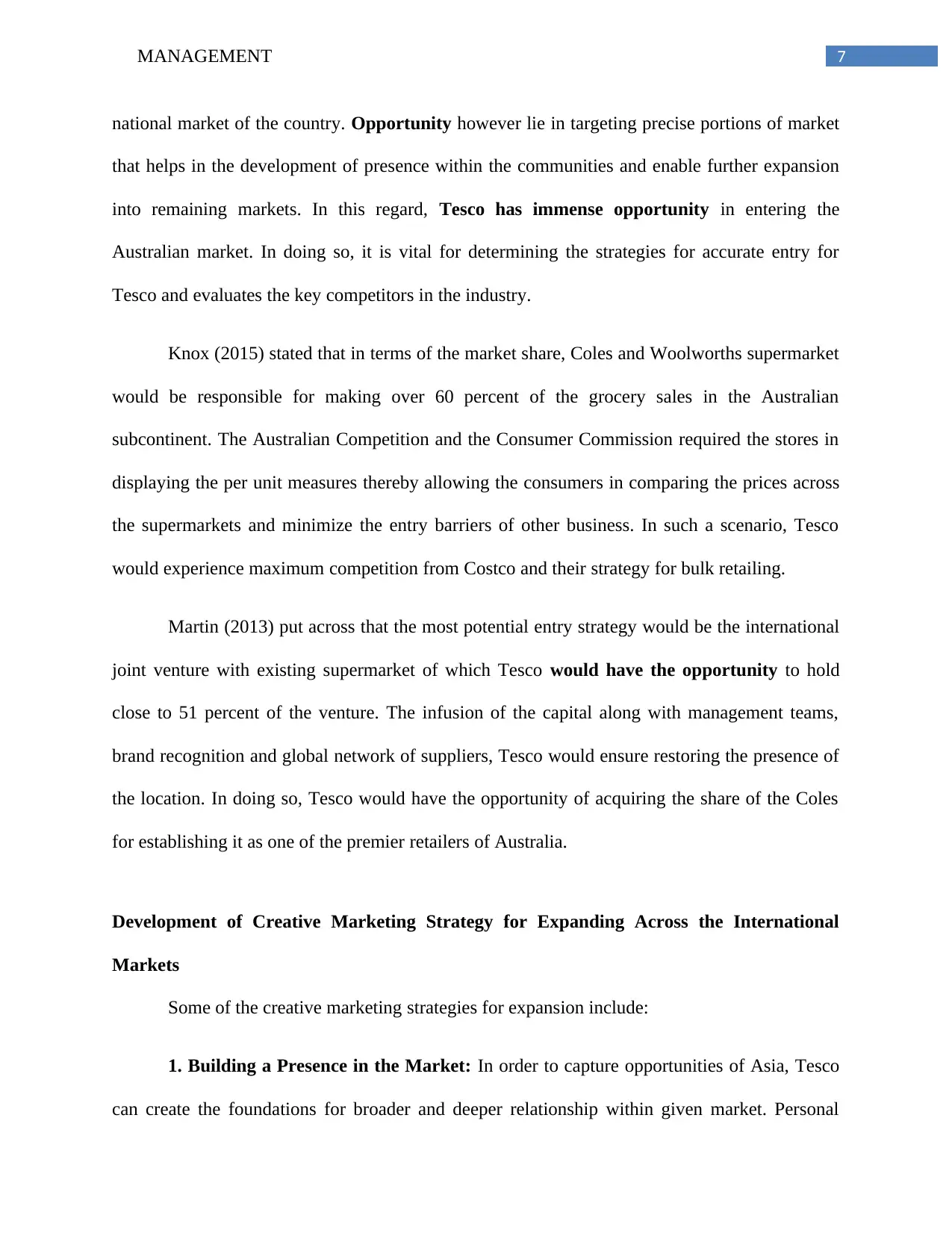
7MANAGEMENT
national market of the country. Opportunity however lie in targeting precise portions of market
that helps in the development of presence within the communities and enable further expansion
into remaining markets. In this regard, Tesco has immense opportunity in entering the
Australian market. In doing so, it is vital for determining the strategies for accurate entry for
Tesco and evaluates the key competitors in the industry.
Knox (2015) stated that in terms of the market share, Coles and Woolworths supermarket
would be responsible for making over 60 percent of the grocery sales in the Australian
subcontinent. The Australian Competition and the Consumer Commission required the stores in
displaying the per unit measures thereby allowing the consumers in comparing the prices across
the supermarkets and minimize the entry barriers of other business. In such a scenario, Tesco
would experience maximum competition from Costco and their strategy for bulk retailing.
Martin (2013) put across that the most potential entry strategy would be the international
joint venture with existing supermarket of which Tesco would have the opportunity to hold
close to 51 percent of the venture. The infusion of the capital along with management teams,
brand recognition and global network of suppliers, Tesco would ensure restoring the presence of
the location. In doing so, Tesco would have the opportunity of acquiring the share of the Coles
for establishing it as one of the premier retailers of Australia.
Development of Creative Marketing Strategy for Expanding Across the International
Markets
Some of the creative marketing strategies for expansion include:
1. Building a Presence in the Market: In order to capture opportunities of Asia, Tesco
can create the foundations for broader and deeper relationship within given market. Personal
national market of the country. Opportunity however lie in targeting precise portions of market
that helps in the development of presence within the communities and enable further expansion
into remaining markets. In this regard, Tesco has immense opportunity in entering the
Australian market. In doing so, it is vital for determining the strategies for accurate entry for
Tesco and evaluates the key competitors in the industry.
Knox (2015) stated that in terms of the market share, Coles and Woolworths supermarket
would be responsible for making over 60 percent of the grocery sales in the Australian
subcontinent. The Australian Competition and the Consumer Commission required the stores in
displaying the per unit measures thereby allowing the consumers in comparing the prices across
the supermarkets and minimize the entry barriers of other business. In such a scenario, Tesco
would experience maximum competition from Costco and their strategy for bulk retailing.
Martin (2013) put across that the most potential entry strategy would be the international
joint venture with existing supermarket of which Tesco would have the opportunity to hold
close to 51 percent of the venture. The infusion of the capital along with management teams,
brand recognition and global network of suppliers, Tesco would ensure restoring the presence of
the location. In doing so, Tesco would have the opportunity of acquiring the share of the Coles
for establishing it as one of the premier retailers of Australia.
Development of Creative Marketing Strategy for Expanding Across the International
Markets
Some of the creative marketing strategies for expansion include:
1. Building a Presence in the Market: In order to capture opportunities of Asia, Tesco
can create the foundations for broader and deeper relationship within given market. Personal
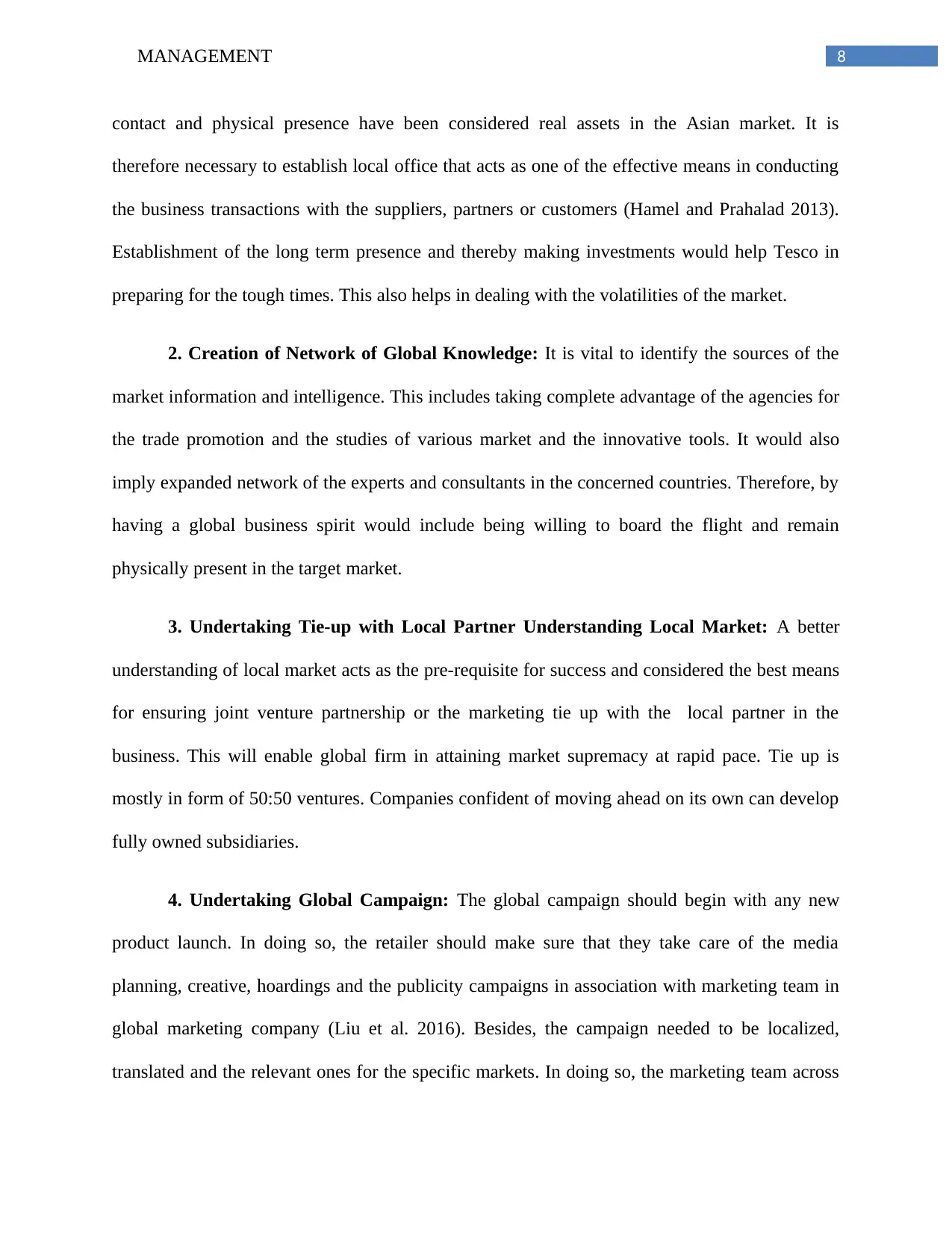
8MANAGEMENT
contact and physical presence have been considered real assets in the Asian market. It is
therefore necessary to establish local office that acts as one of the effective means in conducting
the business transactions with the suppliers, partners or customers (Hamel and Prahalad 2013).
Establishment of the long term presence and thereby making investments would help Tesco in
preparing for the tough times. This also helps in dealing with the volatilities of the market.
2. Creation of Network of Global Knowledge: It is vital to identify the sources of the
market information and intelligence. This includes taking complete advantage of the agencies for
the trade promotion and the studies of various market and the innovative tools. It would also
imply expanded network of the experts and consultants in the concerned countries. Therefore, by
having a global business spirit would include being willing to board the flight and remain
physically present in the target market.
3. Undertaking Tie-up with Local Partner Understanding Local Market: A better
understanding of local market acts as the pre-requisite for success and considered the best means
for ensuring joint venture partnership or the marketing tie up with the local partner in the
business. This will enable global firm in attaining market supremacy at rapid pace. Tie up is
mostly in form of 50:50 ventures. Companies confident of moving ahead on its own can develop
fully owned subsidiaries.
4. Undertaking Global Campaign: The global campaign should begin with any new
product launch. In doing so, the retailer should make sure that they take care of the media
planning, creative, hoardings and the publicity campaigns in association with marketing team in
global marketing company (Liu et al. 2016). Besides, the campaign needed to be localized,
translated and the relevant ones for the specific markets. In doing so, the marketing team across
contact and physical presence have been considered real assets in the Asian market. It is
therefore necessary to establish local office that acts as one of the effective means in conducting
the business transactions with the suppliers, partners or customers (Hamel and Prahalad 2013).
Establishment of the long term presence and thereby making investments would help Tesco in
preparing for the tough times. This also helps in dealing with the volatilities of the market.
2. Creation of Network of Global Knowledge: It is vital to identify the sources of the
market information and intelligence. This includes taking complete advantage of the agencies for
the trade promotion and the studies of various market and the innovative tools. It would also
imply expanded network of the experts and consultants in the concerned countries. Therefore, by
having a global business spirit would include being willing to board the flight and remain
physically present in the target market.
3. Undertaking Tie-up with Local Partner Understanding Local Market: A better
understanding of local market acts as the pre-requisite for success and considered the best means
for ensuring joint venture partnership or the marketing tie up with the local partner in the
business. This will enable global firm in attaining market supremacy at rapid pace. Tie up is
mostly in form of 50:50 ventures. Companies confident of moving ahead on its own can develop
fully owned subsidiaries.
4. Undertaking Global Campaign: The global campaign should begin with any new
product launch. In doing so, the retailer should make sure that they take care of the media
planning, creative, hoardings and the publicity campaigns in association with marketing team in
global marketing company (Liu et al. 2016). Besides, the campaign needed to be localized,
translated and the relevant ones for the specific markets. In doing so, the marketing team across
⊘ This is a preview!⊘
Do you want full access?
Subscribe today to unlock all pages.

Trusted by 1+ million students worldwide
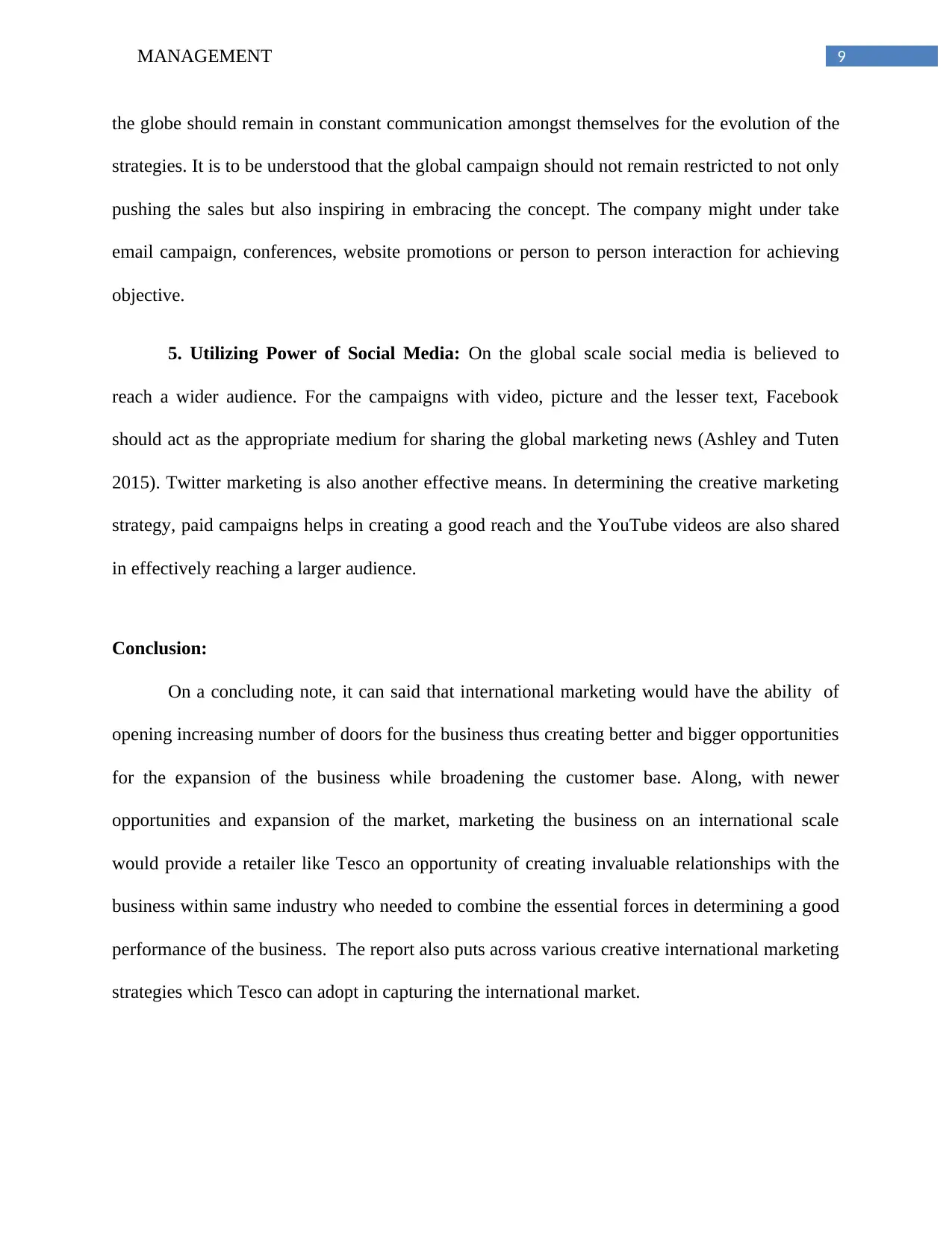
9MANAGEMENT
the globe should remain in constant communication amongst themselves for the evolution of the
strategies. It is to be understood that the global campaign should not remain restricted to not only
pushing the sales but also inspiring in embracing the concept. The company might under take
email campaign, conferences, website promotions or person to person interaction for achieving
objective.
5. Utilizing Power of Social Media: On the global scale social media is believed to
reach a wider audience. For the campaigns with video, picture and the lesser text, Facebook
should act as the appropriate medium for sharing the global marketing news (Ashley and Tuten
2015). Twitter marketing is also another effective means. In determining the creative marketing
strategy, paid campaigns helps in creating a good reach and the YouTube videos are also shared
in effectively reaching a larger audience.
Conclusion:
On a concluding note, it can said that international marketing would have the ability of
opening increasing number of doors for the business thus creating better and bigger opportunities
for the expansion of the business while broadening the customer base. Along, with newer
opportunities and expansion of the market, marketing the business on an international scale
would provide a retailer like Tesco an opportunity of creating invaluable relationships with the
business within same industry who needed to combine the essential forces in determining a good
performance of the business. The report also puts across various creative international marketing
strategies which Tesco can adopt in capturing the international market.
the globe should remain in constant communication amongst themselves for the evolution of the
strategies. It is to be understood that the global campaign should not remain restricted to not only
pushing the sales but also inspiring in embracing the concept. The company might under take
email campaign, conferences, website promotions or person to person interaction for achieving
objective.
5. Utilizing Power of Social Media: On the global scale social media is believed to
reach a wider audience. For the campaigns with video, picture and the lesser text, Facebook
should act as the appropriate medium for sharing the global marketing news (Ashley and Tuten
2015). Twitter marketing is also another effective means. In determining the creative marketing
strategy, paid campaigns helps in creating a good reach and the YouTube videos are also shared
in effectively reaching a larger audience.
Conclusion:
On a concluding note, it can said that international marketing would have the ability of
opening increasing number of doors for the business thus creating better and bigger opportunities
for the expansion of the business while broadening the customer base. Along, with newer
opportunities and expansion of the market, marketing the business on an international scale
would provide a retailer like Tesco an opportunity of creating invaluable relationships with the
business within same industry who needed to combine the essential forces in determining a good
performance of the business. The report also puts across various creative international marketing
strategies which Tesco can adopt in capturing the international market.
Paraphrase This Document
Need a fresh take? Get an instant paraphrase of this document with our AI Paraphraser
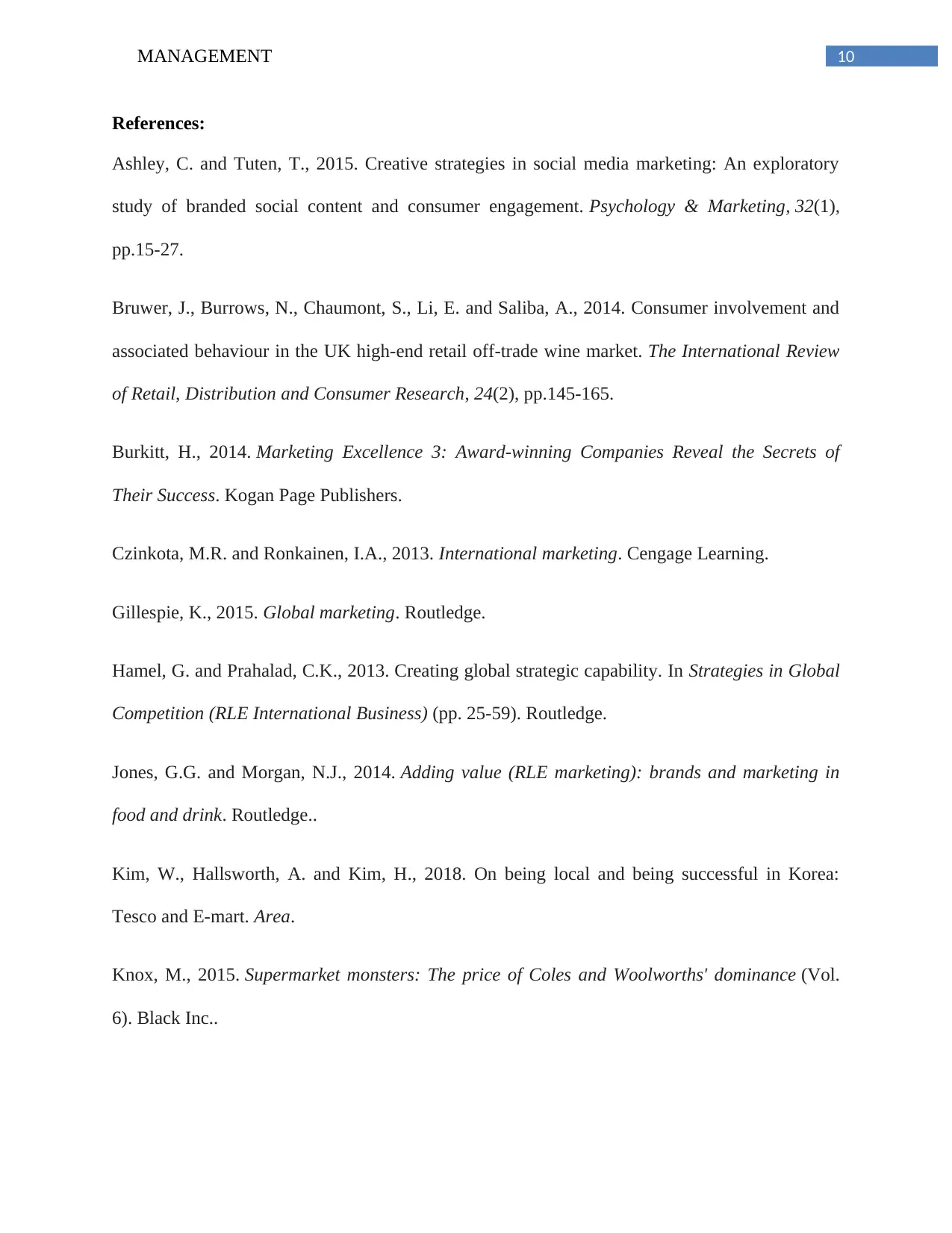
10MANAGEMENT
References:
Ashley, C. and Tuten, T., 2015. Creative strategies in social media marketing: An exploratory
study of branded social content and consumer engagement. Psychology & Marketing, 32(1),
pp.15-27.
Bruwer, J., Burrows, N., Chaumont, S., Li, E. and Saliba, A., 2014. Consumer involvement and
associated behaviour in the UK high-end retail off-trade wine market. The International Review
of Retail, Distribution and Consumer Research, 24(2), pp.145-165.
Burkitt, H., 2014. Marketing Excellence 3: Award-winning Companies Reveal the Secrets of
Their Success. Kogan Page Publishers.
Czinkota, M.R. and Ronkainen, I.A., 2013. International marketing. Cengage Learning.
Gillespie, K., 2015. Global marketing. Routledge.
Hamel, G. and Prahalad, C.K., 2013. Creating global strategic capability. In Strategies in Global
Competition (RLE International Business) (pp. 25-59). Routledge.
Jones, G.G. and Morgan, N.J., 2014. Adding value (RLE marketing): brands and marketing in
food and drink. Routledge..
Kim, W., Hallsworth, A. and Kim, H., 2018. On being local and being successful in Korea:
Tesco and E‐mart. Area.
Knox, M., 2015. Supermarket monsters: The price of Coles and Woolworths' dominance (Vol.
6). Black Inc..
References:
Ashley, C. and Tuten, T., 2015. Creative strategies in social media marketing: An exploratory
study of branded social content and consumer engagement. Psychology & Marketing, 32(1),
pp.15-27.
Bruwer, J., Burrows, N., Chaumont, S., Li, E. and Saliba, A., 2014. Consumer involvement and
associated behaviour in the UK high-end retail off-trade wine market. The International Review
of Retail, Distribution and Consumer Research, 24(2), pp.145-165.
Burkitt, H., 2014. Marketing Excellence 3: Award-winning Companies Reveal the Secrets of
Their Success. Kogan Page Publishers.
Czinkota, M.R. and Ronkainen, I.A., 2013. International marketing. Cengage Learning.
Gillespie, K., 2015. Global marketing. Routledge.
Hamel, G. and Prahalad, C.K., 2013. Creating global strategic capability. In Strategies in Global
Competition (RLE International Business) (pp. 25-59). Routledge.
Jones, G.G. and Morgan, N.J., 2014. Adding value (RLE marketing): brands and marketing in
food and drink. Routledge..
Kim, W., Hallsworth, A. and Kim, H., 2018. On being local and being successful in Korea:
Tesco and E‐mart. Area.
Knox, M., 2015. Supermarket monsters: The price of Coles and Woolworths' dominance (Vol.
6). Black Inc..
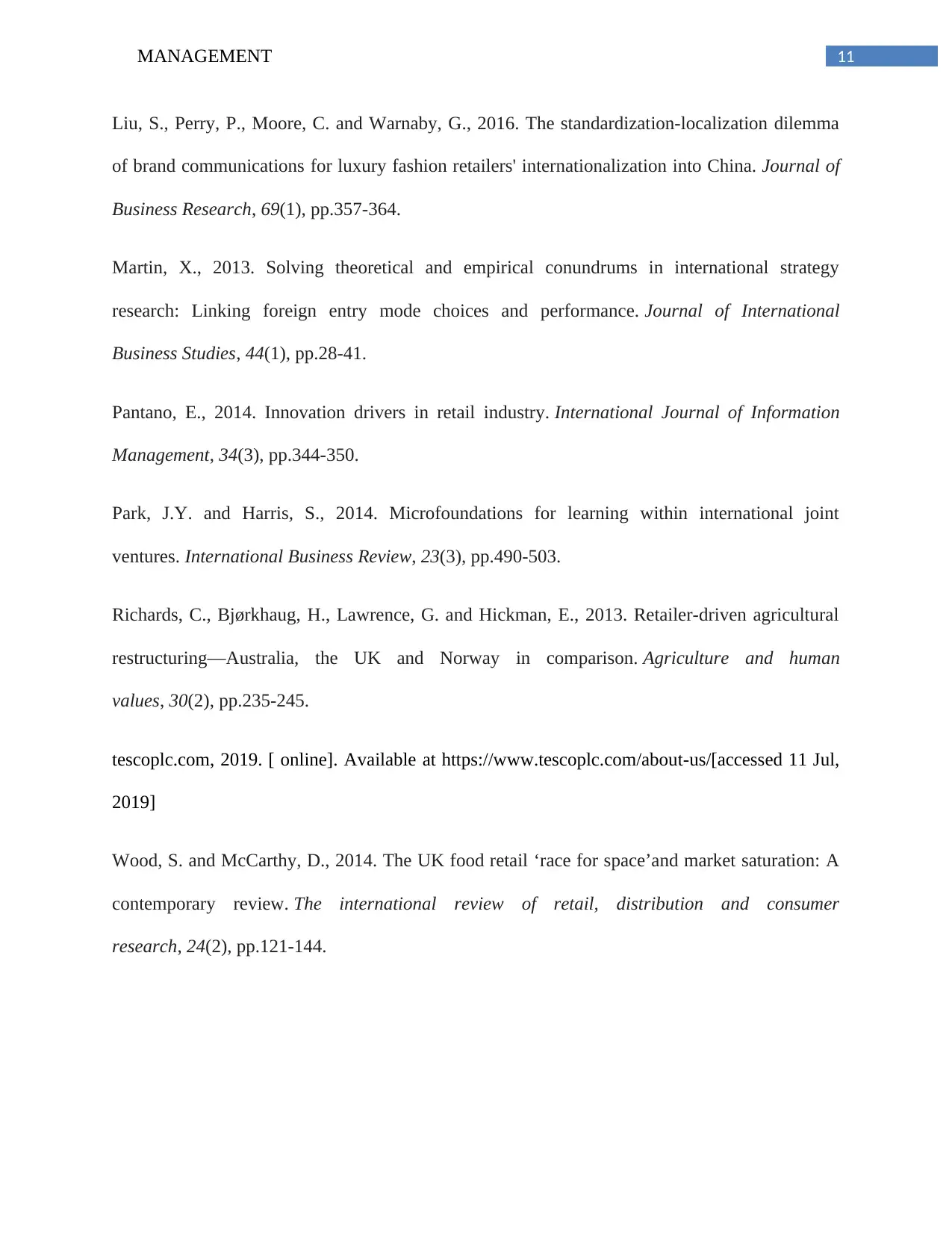
11MANAGEMENT
Liu, S., Perry, P., Moore, C. and Warnaby, G., 2016. The standardization-localization dilemma
of brand communications for luxury fashion retailers' internationalization into China. Journal of
Business Research, 69(1), pp.357-364.
Martin, X., 2013. Solving theoretical and empirical conundrums in international strategy
research: Linking foreign entry mode choices and performance. Journal of International
Business Studies, 44(1), pp.28-41.
Pantano, E., 2014. Innovation drivers in retail industry. International Journal of Information
Management, 34(3), pp.344-350.
Park, J.Y. and Harris, S., 2014. Microfoundations for learning within international joint
ventures. International Business Review, 23(3), pp.490-503.
Richards, C., Bjørkhaug, H., Lawrence, G. and Hickman, E., 2013. Retailer-driven agricultural
restructuring—Australia, the UK and Norway in comparison. Agriculture and human
values, 30(2), pp.235-245.
tescoplc.com, 2019. [ online]. Available at https://www.tescoplc.com/about-us/[accessed 11 Jul,
2019]
Wood, S. and McCarthy, D., 2014. The UK food retail ‘race for space’and market saturation: A
contemporary review. The international review of retail, distribution and consumer
research, 24(2), pp.121-144.
Liu, S., Perry, P., Moore, C. and Warnaby, G., 2016. The standardization-localization dilemma
of brand communications for luxury fashion retailers' internationalization into China. Journal of
Business Research, 69(1), pp.357-364.
Martin, X., 2013. Solving theoretical and empirical conundrums in international strategy
research: Linking foreign entry mode choices and performance. Journal of International
Business Studies, 44(1), pp.28-41.
Pantano, E., 2014. Innovation drivers in retail industry. International Journal of Information
Management, 34(3), pp.344-350.
Park, J.Y. and Harris, S., 2014. Microfoundations for learning within international joint
ventures. International Business Review, 23(3), pp.490-503.
Richards, C., Bjørkhaug, H., Lawrence, G. and Hickman, E., 2013. Retailer-driven agricultural
restructuring—Australia, the UK and Norway in comparison. Agriculture and human
values, 30(2), pp.235-245.
tescoplc.com, 2019. [ online]. Available at https://www.tescoplc.com/about-us/[accessed 11 Jul,
2019]
Wood, S. and McCarthy, D., 2014. The UK food retail ‘race for space’and market saturation: A
contemporary review. The international review of retail, distribution and consumer
research, 24(2), pp.121-144.
⊘ This is a preview!⊘
Do you want full access?
Subscribe today to unlock all pages.

Trusted by 1+ million students worldwide
1 out of 12
Related Documents
Your All-in-One AI-Powered Toolkit for Academic Success.
+13062052269
info@desklib.com
Available 24*7 on WhatsApp / Email
![[object Object]](/_next/static/media/star-bottom.7253800d.svg)
Unlock your academic potential
Copyright © 2020–2025 A2Z Services. All Rights Reserved. Developed and managed by ZUCOL.



